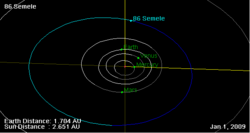Astronomy:86 Semele
 Orbit of 86 Semele on 1 Jan 2009 | |
| Discovery | |
|---|---|
| Discovered by | Friedrich Tietjen |
| Discovery date | January 4, 1866 |
| Designations | |
| (86) Semele | |
| Pronunciation | /ˈsɛmɪlə/[1] |
| Named after | Semele |
| Minor planet category | Main belt |
| Adjectives | Semelean /sɛmɪˈleɪən/[2] |
| Orbital characteristics[3] | |
| Epoch December 31, 2006 (JD 2454100.5) | |
| |{{{apsis}}}|helion}} | 562.652 Gm (3.761 AU) |
| |{{{apsis}}}|helion}} | 369.116 Gm (2.467 AU) |
| 465.884 Gm (3.114 AU) | |
| Eccentricity | 0.208 |
| Orbital period | 2,007.366 d (5.50 a) |
| Average Orbital speed | 16.69 km/s |
| Mean anomaly | 264.875° |
| Inclination | 4.822° |
| Longitude of ascending node | 86.452° |
| 307.886° | |
| Physical characteristics | |
| Dimensions | 120.6 km |
| Mass | 1.8×1018 kg |
Equatorial surface gravity | 0.0337 m/s² |
Equatorial escape velocity | 0.0638 km/s |
| Rotation period | 16.641±0.001 h[4] |
| Geometric albedo | 0.047 [5] |
| C | |
| Absolute magnitude (H) | 8.54 |
Semele (minor planet designation: 86 Semele) is a large and very dark main-belt asteroid with an orbital period of 5.5 years. It is rotating with a period of 16.6 hours, and varies in magnitude by 0.13 during each cycle.[4] This object is classified as a C-type asteroid and is probably composed of carbonates.
Semele was discovered by Germany astronomer Friedrich Tietjen on January 4, 1866.[6] It was his first and only asteroid discovery. It is named after Semele, the mother of Dionysus in Greek mythology.
The orbit of 86 Semele places it in a 13:6 mean motion resonance with the planet Jupiter. The computed Lyapunov time for this asteroid is only 6,000 years, indicating that it occupies a chaotic orbit that will change randomly over time because of gravitational perturbations of the planets. This Lyapunov time is the second lowest among the first 100 named minor planets.[7]
References
- ↑ "Semele". Semele. Oxford University Press. http://www.lexico.com/definition/Semele.
- ↑ Robert Calverley Trevelyan (1898) Mallow and Asphadel, p. 4.
- ↑ Yeomans, Donald K., "86 Semele", JPL Small-Body Database Browser (NASA Jet Propulsion Laboratory), https://ssd.jpl.nasa.gov/sbdb.cgi?sstr=86, retrieved 2013-04-07.
- ↑ 4.0 4.1 Pilcher, Frederick (July 2020). "Lightcurves and Rotation Periods of 83 Beatrix, 86 Semele, 118 Peitho 153 Hilda, 527 Euryanthe, and 549 Jessonda". Bulletin of the Minor Planets Section of the Association of Lunar and Planetary Observers 47 (3): 192–195. Bibcode: 2020MPBu...47..192P.
- ↑ Asteroid Data Sets
- ↑ "Numbered Minor Planets 1–5000", Discovery Circumstances (IAU Minor Planet center), https://www.minorplanetcenter.net/iau/lists/NumberedMPs000001.html, retrieved 2013-04-07.
- ↑ Šidlichovský, M. (1999), Svoren, J.; Pittich, E. M.; Rickman, H., eds., "Resonances and chaos in the asteroid belt", Evolution and source regions of asteroids and comets : proceedings of the 173rd colloquium of the International Astronomical Union, held in Tatranska Lomnica, Slovak Republic, August 24–28, 1998: pp. 297–308, Bibcode: 1999esra.conf..297S.
External links
- 86 Semele at AstDyS-2, Asteroids—Dynamic Site
- 86 Semele at the JPL Small-Body Database
 |

